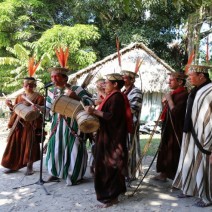2016: A Good Year For Rainforest People, But Hazards Ahead
North America’s Sioux People caught the attention of the world this year by defending their drinking water at Standing Rock, North Dakota; but indigenous people have been defending Mother Earth for centuries, and the Sioux weren’t the only ones to make gains in 2016.

29 December 2016 | In North Dakota, they’re “Water Protectors”, but in many parts of the world, they’re Guardians of the Forest: the indigenous people and forest communities of Latin America, Africa, and Asia who have historically resisted unsustainable development and often given their lives to defend the forest.
The fight is far from won, with deforestation again on the rise in Brazil and Indonesia after years of decline, but 2016 may prove to be a pivotal year for rainforest people, largely because more and more of them are managing to not only protect their forests, but to sustainably engage with the world around them.
It’s a story decades in the making, and one that indigenous leaders Tashka and Linda Yawanawa recounted in October, at the TEDWomen 2016 conference.
Indeed, a report published jointly by the World Resources Institute (WRI), Rights and Resources Initiative (RRI) and Woods Hole Research Center, showing that indigenous people manage forests containing more than 55 trillion metric tons of carbon, and that deforestation rates inside forests legally managed by indigenous peoples and communities are two to three times lower than in other forests, Katie Reytar and Peter Veit of WRI write in a blog post.
Story Continues Below
But the year began with research from RRI showing a slowdown in the recognition of forest tenure rights, even though governments in in 33 low- and middle-income countries have recognized indigenous and community ownership on 388 million hectares of forest land in the last decade and have “designated” an additional 109 million hectares for communities.
The Asháninka do Amônia people of Brazil earned demarcation of their territory from Brazilian authorities in 1992, and in September of this year Ecosystem Marketplace profiled the Asháninka do Amônia people’s journey to self-rule and sustainable development. Community leaders established handicraft and agroforestry businesses while continuing to fend off loggers that would invade their territory. The Asháninka do Amônia’s journey even resulted in a first-of-its-kind indigenous ecosystem services protocol, which they created through a collaboration with Ecosystem Marketplace publisher Forest Trends.
The indigenous people of Peru’s Amarakaeri Communal Reserve (ACR) are also leveraging traditional knowledge and markets to carve out a sustainable existence, and Ecosystem Marketplace explored their sustainable Brazil nut harvesting initiative in November. The Brazil nut activities has attracted a great deal of attention as ACR’s administrating organization, Eca Amarakaeri, won the Innovative Experiences in Latin America contest for it over the summer.
The indigenous communities of ACR were also present during this year’s UN climate talks in Marrakesh, Morocco, working to safeguard indigenous rights in global climate change mitigation efforts. They reiterated their openness to REDD (Reducing Emissions from Deforestation and forest Degradation) projects that support their way of life – but only if that support is assured.
“REDD+ isn’t going ahead if the basic rights of indigenous peoples aren’t observed,” said Edwin Llauta, of the indigenous organization, Eca-Amarakaeri, which administers the ACR.
The organization is involved in what’s known as Indigenous REDD, which seeks to ensure indigenous cultural provisions alongside forest conservation that mitigates climate change.
Outside of international climate negotiations, an online platform called SOMAI Alerta Indígena, which aims to help indigenous people adapt to climate change through better understanding of deforestation patterns and their impacts, got a nod from Google through its Impact Challenge 2016 contest. The SOMAI platform was one of five finalists in the tech giant’s contest, which rewards innovative nonprofits with funds, and won 1.5 million Brazilian Real (USD 43,000). The Amazon Environmental Research Institute (IPAM), which launched SOMAI in 2014, will use the money to develop a mobile app that’s accessible in areas without reliable internet and that includes more frequent climate updates. Fernanda Bortolotto, a researcher working on the platform said involvement in the contest also helped raise awareness.
“The Google recognition over the SOMAI project translates into having the support to decrease the gap between the information produced by researchers and the people that need that information to develop adaptation strategies – namely, the indigenous people of Amazon,” Bortolotto said.
Meanwhile, chefs in Latin America took a shine to unconventional rainforest ingredients in 2016 supporting a movement that aims to use gastronomy as a vehicle for environmental protection and sustainable food production. Chefs in Argentina, Bolivia, Brazil, Colombia, Peru, and Venezuela are collaborating with Forest Trends and Quito-based Canopy Bridge to demonstrate that the Rainforest to Table program can work on a large scale to save rainforests and nourish the communities who call them home.
Correction: An updated version of this article mentions that IPAM was awarded 1.5 million Brazilian Real for being a finalist in the Google Impact Challenge 2016 contest.
Please see our Reprint Guidelines for details on republishing our articles.

